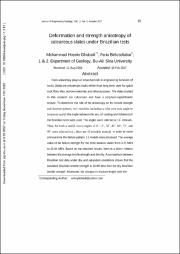Deformation and strength anisotropy of calcareous slates under Brazilian tests
(ندگان)پدیدآور
Ghobadi, Mohammad HoseinBehzadtabar, Pariaنوع مدرک
TextOriginal Manuscript
زبان مدرک
Englishچکیده
Rock anisotropy plays an important role in engineering behavior of rocks. Slates are anisotropic rocks which have long been used for gable roof, floor tiles, borrow materials, and other purposes. The slates studied in this research are calcareous and have a porphyro-lepidoblastic texture. To determine the role of the anisotropy on the tensile strength and fracture pattern, two variables including ψ (the core axis angle to foliation) and β (the angle between the axis of loading and foliation) in the Brazilian tests were used. The angles were selected at 15° intervals. Thus, for both ψ and β, seven angles of 0˚, 15˚, 30˚, 45˚, 60˚, 75˚, and 90˚ were selected (i.e., there are 43 possible modes). In order to name and examine the failure pattern, 11 models were proposed. The average value of the failure strength for the three stations varies from 3.21 MPa to 20.94 MPa. Based on the obtained results, there is a direct relation between the average tensile strength and density. A comparison between Brazilian test data under dry and saturation conditions shows that the saturated Brazilian tensile strength is 30.8% less than the dry Brazilian tensile strength. Moreover, the changes in fracture length with the changes in ψ and β indicate an inverse relation. Eventually, the average of tensile strength (σt) and strength anisotropy index (Ia) demonstrates that the influence of orientation angle (ψ) is much larger than that of foliation-loading angle (β).
کلید واژگان
AnisotropySlate
Brazilian test
Fracture pattern
Tensile strength
Geotecnic
شماره نشریه
3تاریخ نشر
2018-01-011396-10-11
ناشر
دانشگاه خوارزمیشاپا
2228-68377386-8222





